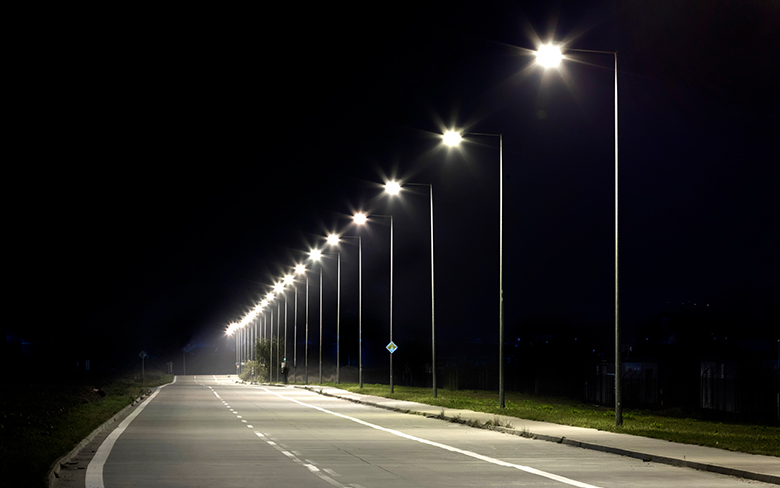
As cities worldwide prioritize sustainability, LED street lights have emerged as one of the most effective ways to reduce energy consumption and environmental impact. By replacing traditional lighting systems with LED technology, municipalities can significantly reduce their carbon footprint, lower energy bills, and contribute to the global movement toward a more eco-friendly future. But what exactly makes LED streetlights such a powerful tool in the fight for sustainability?
Table of Contents
1. Significant Reduction in Energy Consumption
One of the most immediate benefits of LED streetlights is their energy efficiency. LED lights use 50-75% less energy compared to traditional streetlights, such as those that use incandescent or high-pressure sodium lamps. This energy savings translates directly into reduced fossil fuel consumption and lower carbon emissions, helping cities reduce their environmental impact.
According to a study by the U.S. Department of Energy, the widespread adoption of LED streetlights could result in energy savings of approximately 40 terawatt-hours annually in the U.S. alone—enough to power millions of homes each year. This reduction represents a substantial leap toward greener urban environments.
2. Longer Lifespan, Less Waste
Another key advantage of LED streetlights is their extended lifespan. LEDs typically last between 50,000 to 100,000 hours, far outlasting traditional streetlights, which often need to be replaced every few years. Fewer replacements mean less waste going to landfills and a reduction in the resources needed to manufacture new lights. This extended lifespan not only benefits the environment but also cuts down on maintenance costs for municipalities, making LED streetlights a cost-effective option.
3. Reduction in Light Pollution
Traditional streetlights often emit light in all directions, contributing to light pollution—the excessive, misdirected, or obtrusive artificial light that disrupts ecosystems and diminishes the visibility of stars in the night sky. LED streetlights, however, are designed with directional lighting, focusing light exactly where it’s needed, such as on roads and walkways, without excessive spillage into the sky. This reduction in light pollution helps preserve natural nocturnal environments, benefiting both wildlife and human health.
4. Free from Harmful Chemicals
Unlike compact fluorescent lights (CFLs) and other older lighting technologies, LED lights are mercury-free. Many traditional lighting solutions contain harmful chemicals like mercury, which can pose environmental and health hazards if they end up in landfills or water supplies. By switching to LEDs, cities can avoid these risks and ensure that toxic substances are not released into the environment, protecting both ecosystems and human well-being.
5. Lower Heat Emissions
LED streetlights emit significantly less heat compared to traditional lighting systems. Older lighting technologies convert a substantial amount of their energy into heat rather than light, which leads to energy inefficiency and contributes to the urban heat island effect—the phenomenon where cities are warmer than surrounding rural areas due to human activity and infrastructure. By emitting less heat, LED streetlights help mitigate this effect, reducing the need for air conditioning and energy use during warmer months.
6. Integration with Smart City Technologies
LED streetlights are increasingly being integrated with smart technologies, which allow cities to monitor and control lighting levels more efficiently. These smart systems can adjust brightness based on traffic conditions, detect when a light is out, and even conserve energy by dimming lights during low-traffic hours. This adaptability and optimization lead to further energy savings, enhancing the environmental benefits of LED streetlights.
Smart streetlights are also part of broader smart city initiatives, contributing to more efficient urban infrastructure management. These systems not only reduce waste and improve energy efficiency but also allow for real-time adjustments that can increase public safety and further reduce unnecessary energy consumption.
7. Contribution to Reduced Greenhouse Gas Emissions
The widespread adoption of LED streetlights has a significant impact on reducing greenhouse gas emissions. Traditional lighting technologies, particularly in large urban areas, contribute to substantial energy consumption, which in turn leads to higher emissions. By consuming less power and lasting longer, LED streetlights reduce the frequency of replacements, transportation emissions, and manufacturing-related carbon footprints.
According to estimates, replacing conventional streetlights with LEDs worldwide could cut millions of tons of CO2 emissions annually, equivalent to taking millions of cars off the road. This makes LED streetlights a critical component of global strategies aimed at combating climate change.
Conclusion
LED streetlights are more than just a lighting upgrade—they represent a transformative shift in urban infrastructure that significantly reduces environmental impacts. From their energy efficiency and longer lifespan to their reduction in light pollution and absence of harmful chemicals, LED streetlights offer cities an eco-friendly solution that contributes to a sustainable future. As cities continue to expand and modernize, LED streetlights will play a pivotal role in reducing energy consumption, lowering greenhouse gas emissions, and creating greener, more livable urban spaces.